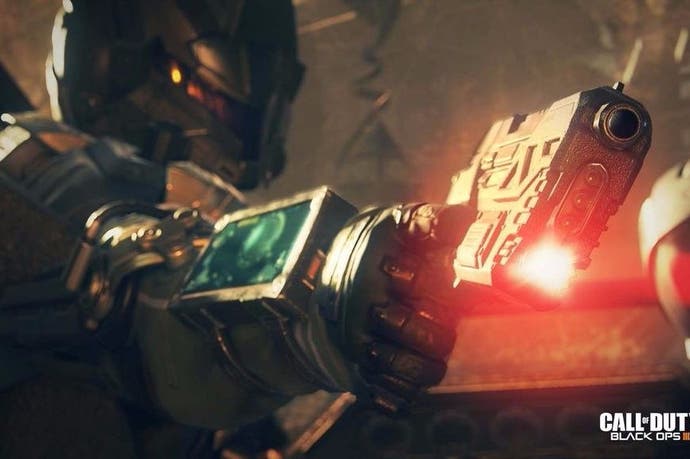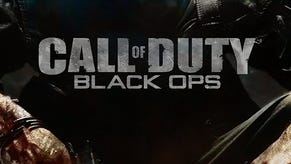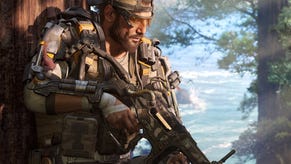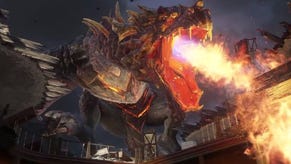Call of Duty Black Ops 3: side-stepping the inevitable comparisons with Titanfall
Wall-runs, power slides and mini-gun wielding robots.
Last year, there were no shortage of comparisons being made between Titanfall, with its robots and athletic jet-boosting soldiers, and Advanced Warfare, Sledgehammer's Call of Duty that introduced an exoskeleton and double-jumping into Activision's long-running series. This year, those comparisons will come thicker and faster. Black Ops 3, with its augmented soldiers and wall-running, is a departure for the series that on first play feels very, very familiar.
Developer Treyarch knows the comparison will come back to them repeatedly before Black Ops 3 launches this November, and it'll be answering questions about the similarities between the two all year long. At the initial reveal, though, it doesn't seem to have its script perfected just yet. "I can only speak for us," says multiplayer director Dan Bunting as he dances around the subject with a message they'll surely be fine-tuning throughout the year.
"We really developed Black Ops 3 as an evolution of Black Ops 2. We didn't stop when that was out the door, it was January 2013, we were just moving forward and the first issue we undertook was movement. Going back to dive to prone when it came into the franchise, that was something we were going to because we wanted to push that repertoire the player has.
"At the beginning of every project we do this thing where we assess all the things we're doing that make Call of Duty special, and make Black Ops special, and chase that. A lot of times people try to chase what Call of Duty's doing and not do it the same way, and we're trying to do what we're doing and make it more special and more unique to us."
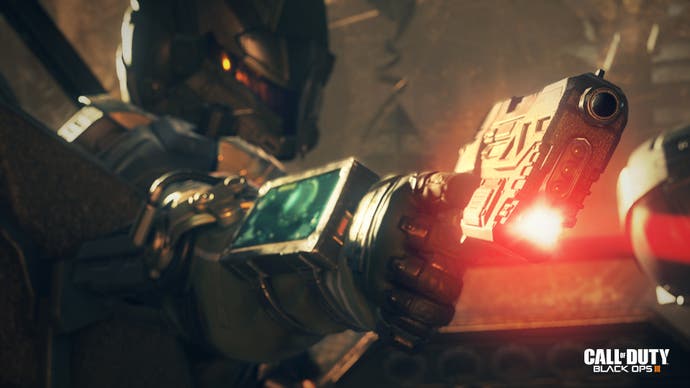
Treyarch's studio head Mark Lamia is willing to be a little more direct in his answer. "Here's what I'll say. Number one, we've been wall-running since Spider-Man - before all of this! Number two, the team's making a movement system. It feels unique. It's integrated into the map design in a way that no other game does. It feels like it's connected, and it's fluid.
"I think it does a disservice to pull one of our systems out and say it's like this other game. Advanced Warfare is its own thing, other games are their own thing and that's cool, we're gamers and they're all fun to play. We wanted to create this very athletic, powerful performer on the battlefield, and all these movements are connected."
Treyarch's most convincing answer, though, comes through letting us play the game. There'll be a beta later this year for those who pre-order, something that hasn't happened since 2008's World at War, and from the very off it's letting press play Black Ops 3's multiplayer - access earlier than I can recall there being in the series' recent history. Even now, over six months before the final release, it feels slick, and it feels complete. You get the sense that Treyarch, a studio that released three games in six weeks in the not-too-distant past, has been ready to show the game for a while ("It's been tough, in a way, for us to hold back all this time," Lamia tells us later).
So yes, Black Ops 3 feels familiar as you bounce between walls and double-jump up to window ledges to mantle through to elevated ground, but it also feels coherent. Treyarch's put thought into how the movement works: all of your enhanced actions are governed by a meter that depletes with each wall-run, each slide-thrust and each double-jump. You can chain actions together, and once you've got your head around some of the possibilities, the moveset is impressive: jumping into a thrust-slide gives you an added boost of power, while you can change direction while wall-running.
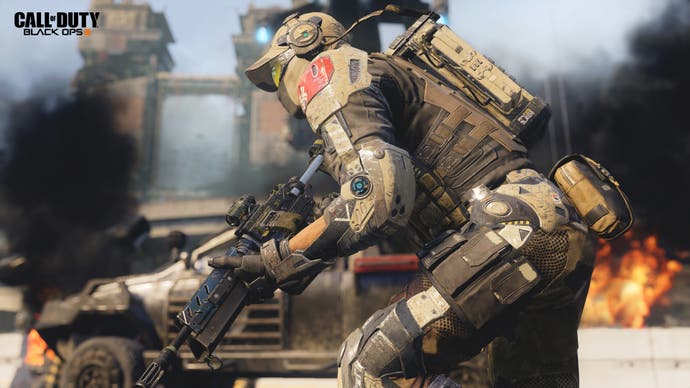
This isn't just traversal, but an added layer to the combat. All the time, in all your movements, your gunsights remain up, and you're free to engage your trigger finger no matter what you're doing. You'll also get unlimited sprint as a default, but that doesn't mean the combat is necessarily quicker. It still feels like it takes slightly longer to down opponents than in other Call of Duty games, and there's a sense of weight and momentum that's been added to movement thanks to the new abilities. It does feel initially a little like Titanfall, but that's no bad thing - and Treyarch's added in its own crinkles, and thought about what that movement means for multiplayer.
So the maps have been tailored to the moveset. They retain the same balance and size that made Black Ops 2's multiplayer so popular. Three are playable in this early demo, across three staple Call of Duty modes: Hardpoint, Domination and Team Deathmatch. They're all slathered in the future sheen of Black Ops 3's fiction, and undercut with a real clarity of design: narrow walkways invite you to bound between their walls, taking you into big open spaces you can leap across or slide through in one thrust, all the time training your sights and engaging in meaty, athletic encounters. There's a flow there that feels new to Call of Duty, and it's a treat to get lost in.
The maps do a good job of keeping you in the action, with no level being bigger than two stories high. There are nice opportunities for taking people by surprise, too - in Combine, a research facility in the Sahara, there's an elevated walkway without a floor that acts as a corridor on the side of the map, allowing you to bypass the exposed courtyard in the middle to get the jump on the opposing team. In Hunted, the most extravagant of the new maps, a waterfall leads into an underwater pathway where you can swim and emerge in the centre of a hunting lodge before going loud.
It's all extremely entertaining, even if our session proves initially intimidating as design director David Vonderhaar stalks the terminals, doing his best Gunnery Sergeant Hartman impersonation as he screams hard-edged encouragement to each of the cowering players. It's as close to authenticity to the military experience that Call of Duty gets these days, and that's okay. Black Ops 3 makes a two-footed leap into the comic book realm, and it should make for a better game.
Take the Specialists, the new class-based characters you level up independently. They're toy-like caricatures taken straight from the back pages of the Argos catalogue, or plucked from the floor of a ten-year-old's bedroom (which makes it harder to swallow the foul-mouthed soundbites Ruin, the hard-edged soldier who pounds Gravity Spikes into the ground, spits out upon a kill).
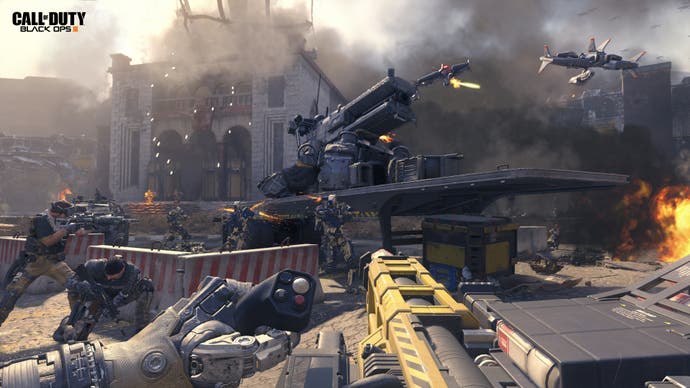
The strange contradiction of a series that revels in dark violence while broadening its appeal to children aside, the Specialists are a lot of fun to tinker with. Of the four introduced at this point, with nine due in the final game, it's compound bow wielding Outrider and glitching war robot Reaper that emerge as the favourites. Specialists have their own weapons and abilities, and you must choose one or the other at the start of the match: then, once a meter's been filled, you have limited access to their special.
In Reaper's case he's got a nifty arm that transforms into a mini-gun with the fetching moniker Scythe, while his Glitch ability flashes him back to his position seconds before. The Scythe, as its name suggests, is a great way of hacking through entire squads, while Glitch is a little more tricky to master, even if it does have equal potential. Outrider, on the other hand, has a bow and arrow that's deliciously analogue in its execution as you hold down the trigger to determine the length and strength of your shot. Her ability is just as handy, a pulse that marks the location of all enemies within range for a short while.
Such outlandish abilities feed into the idea that Black Ops 3 is more like Halo than traditional Call of Duty, something which carries through into its campaign where corridors are swapped out for open arenas patrolled by enemies infused with emergent AI. Some elements of the class system seem to carry over, with the four-player co-op seeing each player take on different roles as they sweep a relatively expansive area, a sniper taking point and scouting the battlefield while other players get involved in the noisy fray. At certain points the player's perspectives all merge - a framing device excused by DNI, or direct neural interface, a key part in Black Ops 3's science fiction.
Details about that fiction are deliberately vague right now, beyond it being set in 2065, with aerial warfare having been shutdown in the aftermath of the airstrikes at the climax of Black Ops 2, and with a new emphasis on ground combat that's ushered in these new augmented super-soldiers. There's more to it than that, of course, and Treyarch is being tellingly coy in where else it could all go.
"It's not Modern Warfare, it's not Advanced Warfare and it's not a World War 2 game," said Mark Lamia. "Black Ops is about the Black Ops missions and what we do. It's just not about a timeframe. In prior games we've moved around in timeframes and you don't know what we've got up our sleeves. We're not bound to any other fiction inside of Call of Duty, and frankly we can take it where we want to. There's a specific story, which we're not getting into the entirety of, which is a thread that runs through it."
There's another arc that runs through the Black Ops series, which tells of how the perception of Treyarch went from them being series stand-ins to the most cherished developer working on Call of Duty. Black Ops 3 isn't a major overhaul of the series, and many of its elements are familiar, but it is a thoughtful one. Judging from how open Treyarch is being with the game in letting us all play it now - we're a long way from Colin the dog and rounder reticules, thank god - it's got confidence in maintaining its reputation. Having played Black Ops 3, I think it's got every right to that.
This article is based on a press trip to Los Angeles. Activision paid for travel and accommodation.
